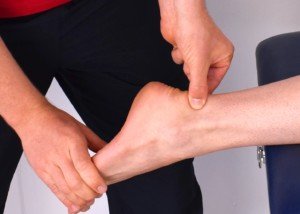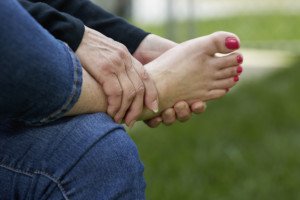
Has a leg or ankle injury caused you to gain weight?
Here are ways to prevent weight gain during your injury recovery without starving yourself or going hungry.
I once read about a woman who gained 40 pounds after breaking her ankle.
Weight gain does not have to happen after a leg or ankle injury.
After a leg or ankle injury, a woman may find herself spending much of the day in a reclined or upright-seated position, with minimal activity on her feet.
This reduction in physical activity, including basic walking, can cause a lot of weight gain in most women.
I’m a former personal trainer, and both of my ankles have suffered sprains (used to play a lot of volleyball; other sprains were from hiking and martial arts).
There are definitely some tricks you can put up your sleeve for the prevention of weight gain.
If a woman, prior to the leg or ankle injury, wasn’t exercising that much, and especially not at all, then she has the greatest potential to prevent weight gain while recovering from the leg or ankle injury.
In the case of the woman who gained 40 pounds, she was NOT doing any upper body workouts; none at all.
In fact, she never did. All her pre-injury physical activity only involved the lower body.
However, if she were to take up strength training, utilizing all her upper body muscles, this would reverse much of that 40-pound weight gain.
But in order for that to take place, the upper body workouts would have to be very comprehensive and intense. Think “Fittest Woman Gym” rather than “Curves.”
If you have an ankle or leg injury that affects only one limb, you can still exercise the other good limb.
If only one side is injured, it’s important to maintain strength in the other leg instead of allowing it to weaken and stiffen up.
A perfectly good limb should be exercised, even if the other leg is disabled.
If you allow the good limb to lose strength, it’ll be that much harder to get around. One good strong leg is better than zero strong legs.
A woman with either a temporary setback from a leg or ankle injury, or a permanent disability with just the one side, can 1) Engage in rigorous upper body workouts, and 2) Engage the good limb in intense workouts.
This commitment will create an incredible variable in the previously inactive woman who suddenly finds herself forced off her feet from a leg or ankle injury.
Upper body strength training should involve all major muscles: back, chest, shoulders, triceps and biceps. Upper body workouts can be done while seated.
Some Seated Upper Body Exercises
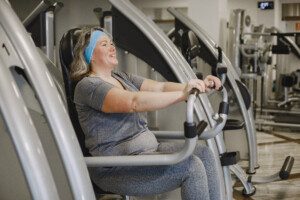
Freepik/prostooleh

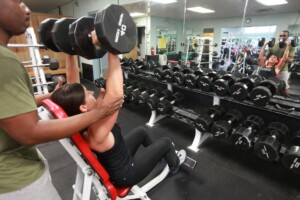

Freepik.com/ArthurHidden
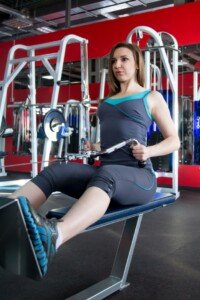
Freepik/yanalya
I cannot think of any reason why a woman with a leg or ankle injury cannot perform upper body strength training while seated.
This can be done at a gym or at home.
Upper body training with weights, especially intensely, will do wonders to prevent weight gain in a previously sedentary woman.
As for exercises with the good leg to prevent the weight gain, a woman can do — with just the non-injured limb — a hamstring curl, or a leg extension.
The machines the extension and curl are designed so that just one limb can perform repetitions.
Again, why neglect training the good limb just because the other is out of commission?
If a woman, prior to the leg or ankle injury, regularly engaged in BOTH upper and lower body workouts, then she’ll have a more challenging time trying to create a calorie-burning variable while recovering.
Whereas the sedentary woman can now introduce the huge variable of upper body workouts, plus working out the good leg; the previously very active woman has no variables to introduce, since she was already working out her entire body before the injury.
But that doesn’t mean there aren’t measures this woman can take to prevent some weight gain.
If her upper body routine had always been quite full and strenuous, she should continue with these upper body routines.
But in addition to continuing the upper body routines, she can introduce a variable such as hitting a punching bag 10 to 20 minutes a day (if her doctor says it’s okay to stand), and moving her arms while watching TV in the same way she’d move them during a step aerobics class.
- Cutting back on unnecessary food such as gravy, butter and soda will also help.
- Make sure you employ portion control with high calorie foods.
 Lorra Garrick is a former personal trainer certified through the American Council on Exercise. At Bally Total Fitness she trained women and men of all ages for fat loss, muscle building, fitness and improved health.
Lorra Garrick is a former personal trainer certified through the American Council on Exercise. At Bally Total Fitness she trained women and men of all ages for fat loss, muscle building, fitness and improved health.
.



